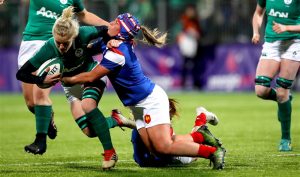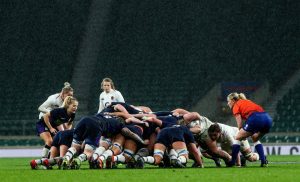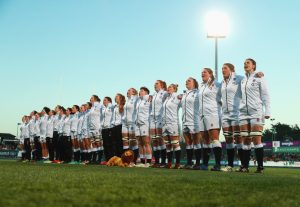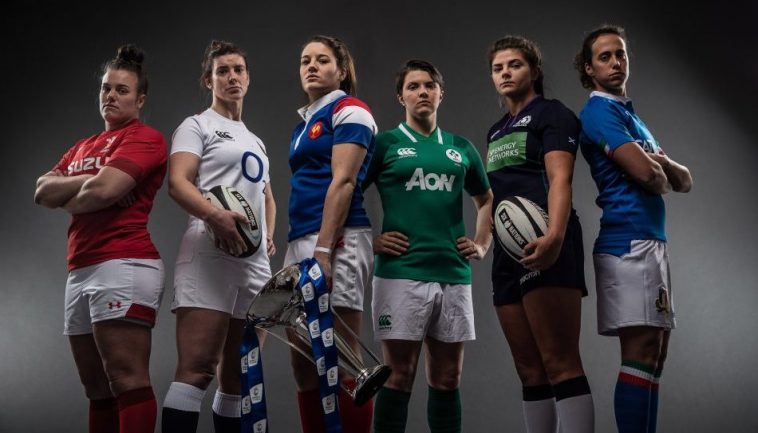The six teams in turn:
FRANCE
Position: 3rd 3 wins, 2 losses
In defence of France’s failure to keep the trophy, we should remember that they made two big calls recently: introducing the new contracts for the 15s players and separating off the two formats of the game. The first should have strengthened their position; the second dramatically weakened it.

France’s Caroline Boujard celebrates scoring a try with teammates (Photo: ©INPHO/Ryan Byrne)
The players brought into the new-look squad are certainly talented, but lacked the big-match experience to hold off the English challenge away from home. It remains to be seen whether the Red Roses, in an almost identical situation, will be able to get a win when they play on French soil next year. To show the size of the challenge, it would be a first victory since a rare visit to Paris in 2012 (15-3). And France’s last win in Albion was at Twickenham (20-30) the following year.
Les Bleues possessed a potential match-winner in Pauline Bourdon, but needed at least one other string-puller of quality to claim the two wins that slipped out of their hands in Doncaster and Padua. And the staff need to decide where best to play her. Constant switching from No 9 to No 10 and back was commonplace 150 years ago, but not in today’s rocket-boosted age.
The French do need to work on their kicking skills. When Jessy Trémoulière, Monserrat Amédée and Caroline Drouin are on the strength, their tactical kicks gain territory and place kicks add crucial points. Their replacements proved to be much less reliable. Even Bourdon missed a conversion from in front of the posts.
Then the crucial question: will they persist with their divided forces come the next World Cup? You suspect they may well shelve the project and bring all their potential match-winners back into the frame. A squad including Amédée, Annery, Drouin, Ladagnous, Mayans, Neisen, Pelle and Trémoulière could yet bring them closer to that long-cherished cup-winners podium.
For all the renown that Olympics Sevens bring, the greatest yearning for French women’s rugby is to go one (or two!) steps better than the seven semi-final places they have achieved thus far.
IRELAND
Position: 5th 1 win, 4 losses
There were a lot of gloomy faces after the hapless defeat at the Arms Park in Round 5. It summed up all the doubts and criticisms that have been aimed at Shamrock Towers since the disheartening results in the home World Cup of 2017.

Ireland’s Claire Molloy with Pauline Bourdon of FranceMandatory (Photo: ©INPHO/Ryan Byrne)
The problems seem to run the gamut, from the overall structures in place for women’s rugby down to management errors at the elite level. These can be sorted only if the people responsible are willing to accept the need for root-and-branch change. Ireland doesn’t enjoy the clear pathway from beginner to international cap that is vital for success. The tiers just below the elite level aren’t properly in place. So 18-year-olds brought into the side haven’t enjoyed the same level of experience that English players have.
The IRFU awarded professional contracts to its 7s squad in late 2018 and the players are now flourishing. The 15s squad is impatiently waiting for the same generosity.
As regards this year’s 6N performances, Claire Molloy, with considerable experience of English playing conditions too, said ‘It’s the finer details that are letting us down. That little bit of ill-discipline. Three or four penalties in a row…then the little switch-offs … but it’s basics for us that we’re not executing… I think what we have to build on is performing for more than just 20, 30 minutes in a game. Which we can show consistently we can do. But we need to hit 60, 70, 80 minutes really, to contest against the Frances and Englands.’
Ireland are a very young squad. They bade goodbye to several outstanding players after the last World Cup; the replacements are still finding their feet at the top level.
They have beaten France three times, in 2009, 2013 and 2017. But in Adam Griggs’ words they came off second best against les Bleues this time round. Fiona Reidy rued the brief moments when Ireland switched off. ‘A side like France will exploit any weakness in the opposition to score points.’
With the recent 24-5 loss to Wales, Irish commentators were depressed and perplexed beyond measure. The last time they lost to them was in 2011. What has gone wrong? Two 6N Championship wins in the 2010s, a semi-final in the 2014 World Cup, and now they lie 5th out of 6. 15s rugby is one of the few sports in Ireland which are capable of competing on the world stage, but as a non-Olympic sport fails to get government backing.
More specifically, a finger was pointed at management errors: a hooker who had never played there before in a 15s game; a complete absence of second-row back-up on the bench throughout the 6N.
And Ireland can’t even be sure of appearing in the New Zealand World Cup without first facing off in qualifying matches.
ITALY
Position: 2nd 3 wins, 1 draw, 1 loss

Inpho
The last day of the tournament brought joy unbound to Italian faces. How appropriate that the final bonus-point winning try was scored by the new skipper, Manuela Furlan. That one extra point ensured a first-ever second place in the Championship – and it was registered against Italy’s greatest rival, France.
In Round 4 Sara Barratin broke the Italian record for caps with 88; in the same match Michela Sillari reached 50. They form part of a tried and tested back line that has been together for several years. Di Giandomenico faces the urgent task of finding adequate replacements for these splendid players.
Up front he is building a powerful pack that can look after itself against all but the very best.
In their last two games against England they were highly competitive in the first-half, then fell away to allow a succession of tries. A trite explanation would be lack of fitness, but beyond that, they couldn’t maintain the game-plan as effectively as before. Not so in the most recent match in Padua: with only a 3-point lead at half-time they might have fallen away. But no, they went immediately on the attack again, racked up points and drained the sap from French veins.
On the national front, they need to broaden the playing strength across the elite clubs. The traditional heartland is the north-east. The sooner they can even up standards across the country, the better.
SCOTLAND
Position: 6th 0 wins, 5 losses
It’s long uphill struggle for the Scots. They lack the player numbers enjoyed by their healthiest rivals, and success breeds success. The head coach, Shade Munro, has toiled manfully to raise standards but has now decided to move on. Let’s hope his successor can find a means to turn the tables.
Two years ago they won two games out of five. Last year they lost away to Wales by a point, then triumphed over Ireland at Donnybrook. Things were looking up. This season they scored two tries away against France, their first in nine years. But their only point came in the harrowingly late loss at home to Wales.

A view of a Scotland scrum Photo: ©INPHO/James Crombie)
And it took a lot of effort to produce those important successes.
One key element missing is a kicking game. As England prove time and time again, one well-placed boot can move the game into enemy territory in the blink of an eye. Then you can start showing off your fancy handling without the fear of a sudden interception giving away easy points. The Scots’ inability to clear their defensive lines with a decisive kick meant that the pick-and-goes multiplied, a tiring operation which too often ended with an error close to the starting point.
Like Wales, they found it hard to get their back line moving fluently and lost turnovers meant misalignments against counter-attacks.
The SRU is putting new structures in place. They can’t come too quickly to support the current players who are fighting so hard for the thistle.
The news that Six Nations results will no longer be considered in deciding World Cup qualification is excellent news for the Scots. In 2017 we had the questionable presence of Hong Kong (ranked 23) to the exclusion of Scotland (ranked 12). This was due to a laudable attempt to widen global interest in the competition. But it meant that World Rugby’s other concern, one-sided matches, was well in evidence (Canada 98 Hong Kong 0; New Zealand 121 Hong Kong 0).
WALES
Position: 4th 2 wins, 1 draw, 2 losses

Wales celebrate after beating Scotland (Photo: ©INPHO/Craig Watson)
It is one of rugby’s most confusing mysteries: why have Wales Women not been able to match the huge successes of their menfolk over the decades?
Only with Scotland’s recent acquisition of another wooden spoon have the Welsh moved off the bottom of that most unwelcome position.
The last-minute win against Scotland was immensely important. Rowland Philips knew its significance for the future of his squad, not least in facing Ireland the following week. And so it proved. To their delight – and many neutrals’ surprise – they defeated the Girls in Green by 19 points.
They share with Scotland a failure to get the back line moving with any regularity. It was significant that for the final round Elinor Snowsill was allowed back into the No 10 shirt. There may have been good reasons for her to be at No 15 or on the bench for the first four games, but they are hard to fathom at this distance.
The advantage of having a highly experienced operator at outside-half is shown all too clearly by Katy Daley-Mclean’s performance. Snowsill is in a similar category: immensely experienced and with a width of skills unmatched by any other Welsh back.
When she moved to No 10 at the end of the England game, the pieces of the Welsh jigsaw started to fall into place. At club level she has been fostering the progress of the young Bristol backs who must be grateful for her guidance.
Once again their front row of Caryl Thomas, Carys Phillips and Amy Evans proved one of the most powerful in the tournament.
Siwan Lillicrap played so well at No 8 that the sad loss to injury of Sioned Harries was partly masked, but with both of them in the back row, Wales would have offered even more strength up front.
They have promising youngsters coming through like Lleucu George, Alex Callender and Alisha Butchers. They need the highest possible level of competition to sharpen their teeth on.
ENGLAND
Professionalism
The figure of 35 contracts on offer was carefully chosen. It ensured that nearly every corner was covered, to provide ample strength in all fifteen positions – the exception was second row, caused by Zoe Aldcroft’s enforced absence.

England England line up (Photo by David Rogers – RFU/The RFU Collection via Getty Images)
But it has led to inevitable difficulties: how to give each of the players the opportunity to show their worth? 100% effort on the training paddock is a given, but when a Six Nations campaign looms, the nation expects only the best on show. Thus far some players have had few opportunities on the pitch to demonstrate their qualities. They must hope that they will get more on the summer tour (See below). Those with long-term experience in test match rugby are known quantities; by contrast the newer caps, players like Jo Brown, Claudia Macdonald and Carys Williams, had little chance to press their claims. Their total playing time this series was 34, 15 and 15 minutes respectively.
This has been no easy matter for the management. They understood the enormity of the decision the players took in accepting these long-desired contracts, but inevitably, you feel, one or two may be required to return to the job market. And this is a position directly parallel to that of the old amateur days.
So the cynic might wonder whether it’s better to be off injured. The Red Roses have had to manage without the talents of Zoe Aldcroft – once again the second-row choices have been dominated by two players (memo: Tamara Taylor and Harriet Millar-Mills played every minute of the 2017 6N) – Justine Lucas, Lagi Tuima, Lydia Thompson and, looking back a stage further, the uncontracted Amber Reed, Millar-Mills and Laura Keates. Ellena Perry is the one junior squad member to suffer the misfortune of getting injured before she could stake her claim powerfully.
If anyone has a bright idea about how to play four match-winning wingers in the same team at the same time, they should contact the management pronto!
Potential room for manoeuvre comes with the Development squad, now dubbed the National Academy side. Of all the contracted players; only 23 can be involved in a test at a time. That leaves a dozen unemployed. Add to them the U20 squad which currently numbers 37, (after their tour to the New World they had only three games on their timetable, one against the Army, two against France); then the leading players in the Tyrrells not under contract such as Poppy Leitch and Rosie Galligan, who both appeared for the Red Roses in the 6N. With all of them you have the makings of one or even two distinctly strong back-up teams for the Red Roses. And they need more game time at international level.
There are a host of possible opponents keen to play them: Spain, who remain desperate to be readmitted to the 6N; then other European nations who used to play against England back in the past: the Netherlands, Germany, Georgia, Russia – and more beyond.
There are very few areas of major concern for the management.
After three rounds the new forwards coach Richard Blaze was impressed with his front-row charges, while pointing out that with so many having changed position the focus for improvement was on set-piece technique.
‘… they’re the best athletes we’ve got,’ he said. “They’re good at ball-carrying, they’re aggressive and physical, and what we work on more is the technical side – the scrum, maul, lineout lifting.’
But it is unfinished business. Neither Shaunagh Brown nor Bryony Cleall have made a cast-iron case for their retention as prop forwards. Both are admirable back-row players, but there is competition for places there.
Out in the backs the major point of interest was the choice of Zoe Harrison in the No 12 shirt – and not as a one-off, but right through the series. She showed up really well, linking, running and kicking as to the manner born. She must be in line to inherit the No 10 shirt whenever that becomes available – on current showing not for a few decades yet.
Centre had looked like one of the richest areas of wealth for England: the returning Emily Scarratt, her first-choice partner at the last World Cup, Rachael Burford, then the contracted Lagi Tuima (sadly injured), Tatyana Heard, Carys Williams, and the injured and uncontracted Amber Reed. But Harrison scooped the jackpot.
The general skill level is enormously high. We have only to watch a passage of interplay between forwards and backs to see the ball-management they all possess. How’s this for a passage of play?
11 – 15 – 9 – 6 – 4 – 10 – 13 – 14 – 9 – 12 – 1 – 9 – 10 – 8 – 9 – 10 – 12 – 3 – 9 – 8 – 12 – 8 – 4 – 6 – TRY
Then an area where all five other nations are under-performing – the kick. Quite apart from Daley-Mclean and Scarratt (the known practitioners), Zoe Harrison, Sarah McKenna and Emily Scott can all boot the ball accurately over vast distances and plant difficult conversions between the sticks.
There are fewer excuses for below-par performances in this aspect of the game. Players can practice the art on their own or in pairs to their heart’s content. The reward is winning a game in the 81st minute with a vital conversion. Ask Lleucu George.
It has been fascinating watching England’s progress through this year’s championship. Some of the time you think you are watching automata at play. ‘There’s a situation’ – ‘I react like this’. Players move quickly into position to exploit the new possession. The analysts confirm that they led the tournament in fast clear-outs. But then it suddenly becomes heads-up rugby, an instinctive off-the-cuff reaction to the game situation. This combination brings excitement and satisfaction in equal measure.
I’ve mentioned before the remarkable number of tries scored on the left wing in recent years. All six of Jess Breach’s in her debut against Canada in 2017 were there. But this season she has played four of the five matches on the other side of the field. That hasn’t bothered her team-mates, anxious to get the ball in her hands as early as possible. The sureness of their passing skills – from No 1 to 15 – is further proof of their safe hands.
Latest News
So the summer tour is a return of the Super Series in North America in June – the first since 2016 – not a trip down under to get a taste of rugby in New Zealand before the World Cup. It will be based at the Chula Vista Elite Training Center in Southern California.
USA Rugby has really gone to town on this plan. Three invitation teams have become four, and they are the four ranked above the fifth-placed hosts: New Zealand, England, France and Canada. This takes the long-established Super Series up a few notches, and will be fought over tooth and nail by the competing nations. Of that we can be sure. It is no accident that the last scheduled fixture is between the top two ranked nations in the world. It should be a humdinger.
What odds on a similar tournament for nations ranked 6-10 in some sunny corner of the world?









